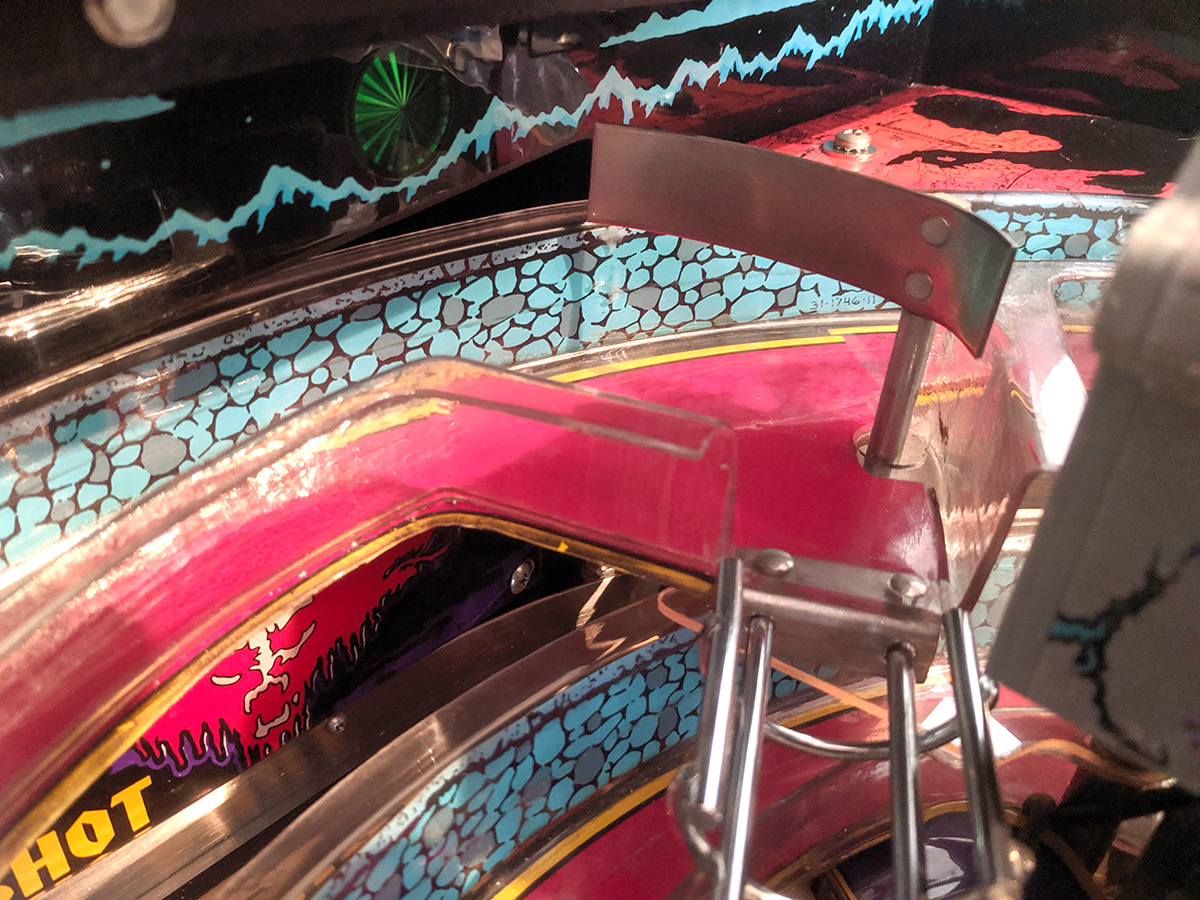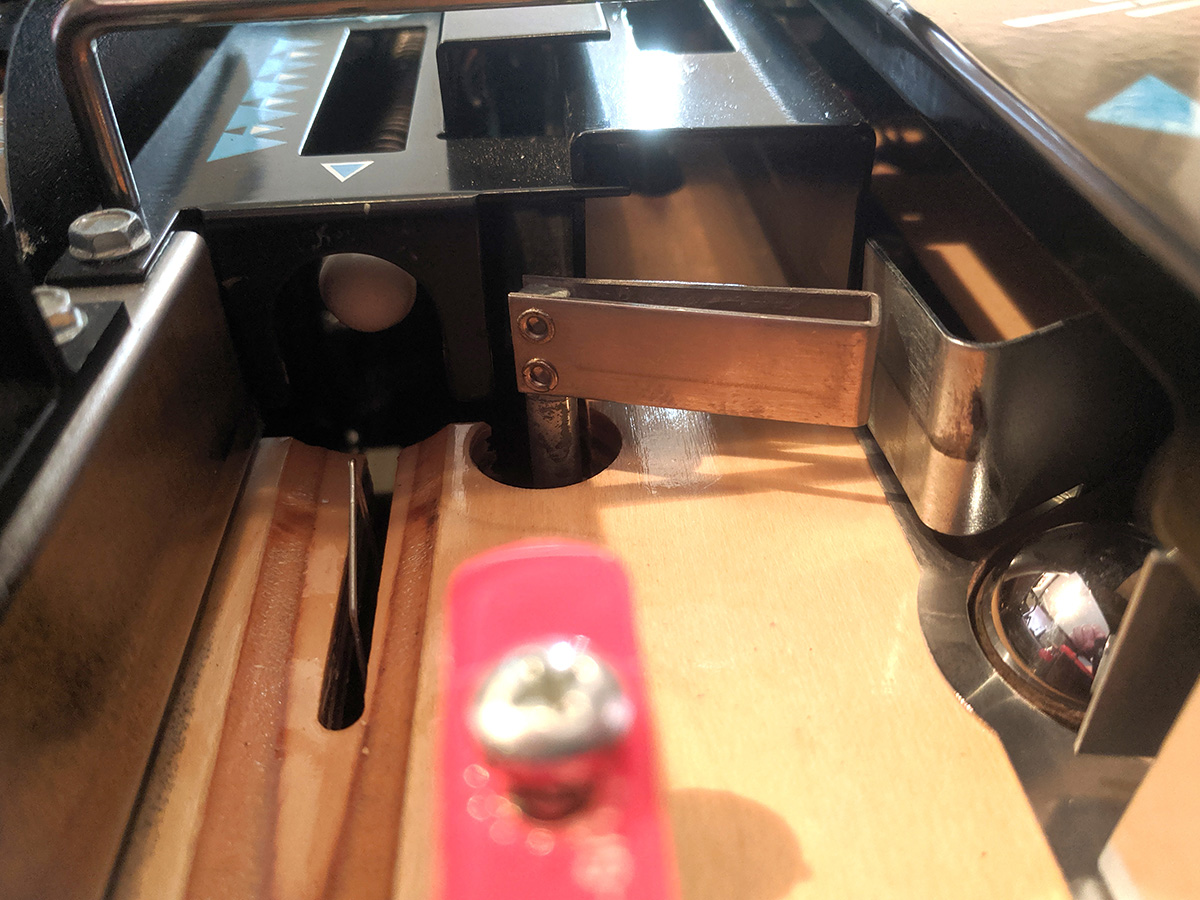Diverters
Related Config File Sections:
In MPF, a diverter (sometimes spelled "divertor") is anything that alters the path of the ball based on the state it's in, including:


- A traditional diverter which is a metal flap at the end of a rod, typically used on ramps to "divert" the ball one way or the other.
- A coil-controlled post that pops up (or down) to let the ball either pass over it or bounce back in some other direction. (This is sometimes called an "up/down" post.)
- A coil-controlled gate, typically which only allows the ball to flow through it in a single direction, but lifted out of the way via a coil when active which allows the ball to travel through it in both directions.
- A "trap door" pop-up which captures the ball when it's up but lets the ball roll over it to another shot when it's down. (Like the trap door / basement in Theatre of Magic.)
- A single drop target that blocks the entrance to a shot when it's up, such as in the back of the saucer in Attack from Mars or the ones that block the ramps in Ghostbusters.
- Something else completely custom, such as the Ringmaster in Cirqus Voltaire. (When it's up the ball can hit it and drop down under the playfield, and when it's down the ball rolls over it and hits standup targets behind it.)
At this point you might be thinking, "Wait, you consider a trap door or the Ringmaster to be a diverter?? What???" But if you think about it from the perspective of pinball software, yeah, trap doors and the Ringmaster are diverters because when then are not active, a ball shot to them goes towards one place, and when they're active, a ball is "diverted" to go somewhere else.
In MPF, a diverter (sometimes spelled "divertor") is anything that alters the path of the ball based on the state it's in, including:


- A traditional diverter which is a metal flap at the end of a rod, typically used on ramps to "divert" the ball one way or the other.
- A coil-controlled post that pops up (or down) to let the ball either pass over it or bounce back in some other direction. (This is sometimes called an "up/down" post.)
- A coil-controlled gate, typically which only allows the ball to flow through it in a single direction, but lifted out of the way via a coil when active which allows the ball to travel through it in both directions.
- A "trap door" pop-up which captures the ball when it's up but lets the ball roll over it to another shot when it's down. (Like the trap door / basement in Theatre of Magic.)
- A single drop target that blocks the entrance to a shot when it's up, such as in the back of the saucer in Attack from Mars or the ones that block the ramps in Ghostbusters.
- Something else completely custom, such as the Ringmaster in Cirqus Voltaire. (When it's up the ball can hit it and drop down under the playfield, and when it's down the ball rolls over it and hits standup targets behind it.)
At this point you might be thinking, "Wait, you consider a trap door or the Ringmaster to be a diverter?? What???" But if you think about it from the perspective of pinball software, yeah, trap doors and the Ringmaster are diverters because when then are not active, a ball shot to them goes towards one place, and when they're active, a ball is "diverted" to go somewhere else.) note
Note
MPF's diverters are integrated with Ball Devices and MPF's ball management and routing system so they can be used to ensure that MPF is able to move balls to where they need to be.
Most diverters are held in their "on" position as long as their driver coil enabled, and then when they're disabled they return back to their off position. That said, some are different. The Ringmaster has a motor which raises and lowers it, and drop targets have coils that are just pulsed to raise/lower them, so this is not a hard and fast rule.
So based on all that, let's look at how the MPF actually handles diverters. At the most basic level, most diverters are just a coil, so fundamentally we don't really need to do anything special to control a diverter. As a game programmer you just need to enable a coil. But if you want to program your game code to control a diverter, there's a lot of glue you need to fully integrate it into your machine, and that's the glue that we've pre-written into our diverter device code.
For example, many diverters attached to ramps do not hold their coils in the "on" position for the entire time that they're on. Instead they use the ramp entry switch to see when a ball is coming their way, and when one is they quickly activate so they can catch the ball in time to divert it. They also typically have a timeout where they deactivate themselves if they don't actually see a ball get diverted, (like with a weak ramp shot that trips the ramp entry switch but that isn't powerful enough to make it all the way up the ramp to the diverter.)
MPF's diverter devices also include support for automatic enabling and disabling (based on events), and they include intelligence to know which target devices a diverter will send a ball to when it's enabled or disabled.
Understanding the difference between "enabling" and "activating" diverters
When talking about diverters in MPF, we use the terms activate and enable (as well as deactivate and disable). Even though these words sound like they're the same thing, they're actually different, so it's important to understand them.
When a diverter is active, that means it's physically activated in its active position. A diverter that is enabled means that it's ready to be activated, but it's not necessarily active at this time. To understand this, let's step through an example.
Imagine a typical ramp in a pinball machine which has one entrance and two exits. These kinds of ramps usually have a diverter at the top of them that can send the ball down one of the two paths. When the diverter is inactive (its default state), the ball goes down one path, and when the diverter is active, the ball is sent down the other path (perhaps towards a ball lock).
There is typically an entrance switch on the ramp which lets the game know that a ball is potentially headed towards that diverter, so when the game wants to route the ball to the "other" ramp exit, rather than turning on that diverter and holding it on forever, the game just watches for that ramp entry switch and then quickly fires the diverter to route the ball to the other exit. Then once the ball passes by the diverter, it hits a second switch which turns off the diverter. (Typically the diverter activation also has a timeout which is used when a weak shot is made where the ball trips the ramp entrance switch but doesn't actually make it all the way up the ramp to the diverter.)
So in MPF parlance, we say that the diverter is enabled whenever it's ready to be fired, but it's not actually active until the coil is physically on.
Again using our example, let's say we have a ramp with a diverter, and when that diverter is active it sends a ball into a lock. When the game starts, the diverter is disabled and inactive. Ramp shots just go up the ramp and come out the default path, and the diverter ignores the ramp entrance switch.
Then when the player does whatever they need to do to light the lock, the diverter is enabled. At this point the diverter is not active since it's not actually firing, but it's enabled (which means it's ready to fire) and the diverter is watching that ramp entrance switch. (So the diverter is enabled but inactive.) Then when the player shoots the ball up that ramp, the diverter sees the ramp entrance switch hit and the diverter activates. (So now the diverter is enabled and active.)
Then once the ball passes by the diverter, the diverter deactivates. At this point whether the diverter is disabled or enabled depends on the game logic. If the lock should stay lit, then the diverter remains enabled even though it's not active, and if the player has to do something else to re-light the lock, then the diverter is disabled and inactive.
Hopefully that makes sense? :)
Monitorable Properties
For
dynamic values and
conditional events, the prefix for diverters is device.diverters.(name).
active
: Boolean (true/false) as to whether this diverter is actively on and in the powered state.
enabled
: Boolean (true/false) as to whether this diverter is enabled (meaning it will be activated when a ball approaches it).
eject_state
: Boolean (true/false) which shows whether this diverter will be activating to route a ball eject from an upstream ball device.
Related How To guides
Related Events
- diverter_(name)_enabling
- diverter_(name)_disabling
- diverter_(name)_activating
- diverter_(name)_deactivating
Something missing or wrong? You can fix it!
This website is edited by people like you! Is something wrong or missing? Is something out of date, or can you explain it better?
Please help us! You can fix it yourself and be an official "open source" contributor!
It's easy! See our Beginner's guide to editing the docs.
Page navigation via the keyboard: < >
You can navigate this site via the keyboard. There are two modes:
General navigation, when search is not focused:
- F , S , / : open search dialog
- P , , : go to previous page
- N , . : go to next page
While using the search function:
- Down , Up : select next / previous result
- Esc , Tab : close search
- Enter : go to highlighted page in the results